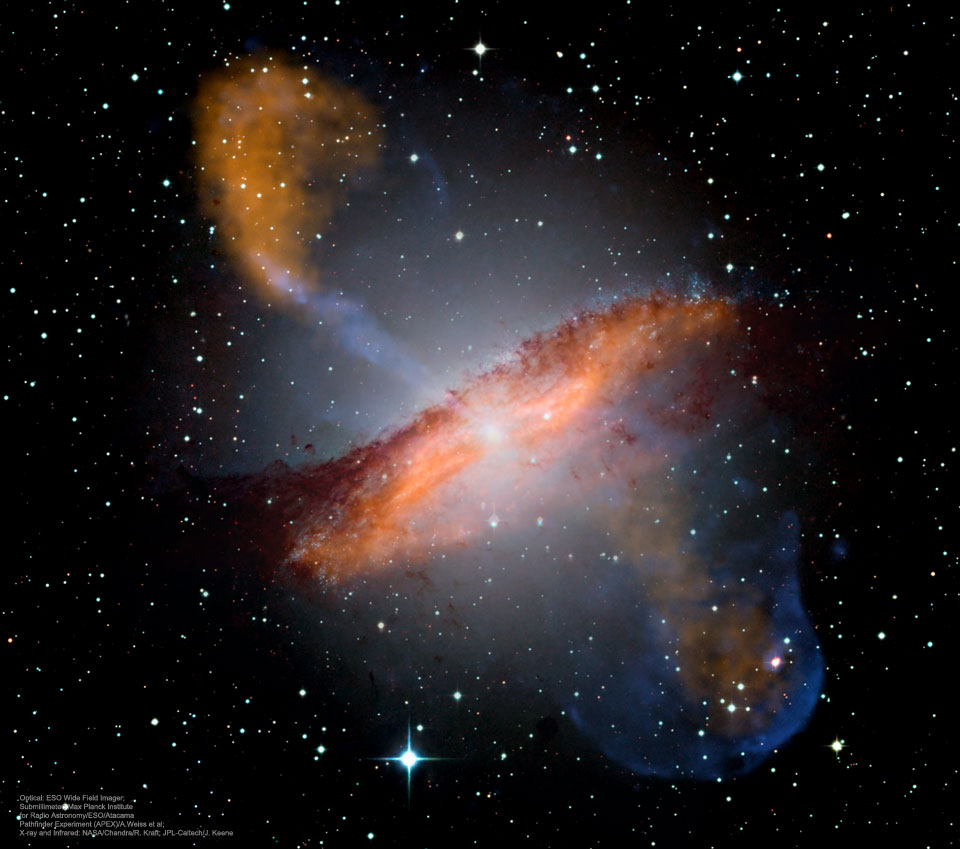2021年04月21日
Centaurus A’s Warped Magnetic Fields
Image Credit: Optical: European Southern Observatory (ESO) Wide Field Imager; Submillimeter: Max Planck Institute for Radio Astronomy/ESO/Atacama Pathfinder Experiment (APEX)/A.Weiss et al; X-ray and Infrared: NASA/Chandra/R. Kraft; JPL-Caltech/J. Keene; Text: Joan Schmelz (USRA)
Explanation: When galaxies collide — what happens to their magnetic fields? To help find out, NASA pointed SOFIA, its flying 747, at galactic neighbor Centaurus A to observe the emission of polarized dust — which traces magnetic fields. Cen A’s unusual shape results from the clash of two galaxies with jets powered by gas accreting onto a central supermassive black hole. In the resulting featured image, SOFIA-derived magnetic streamlines are superposed on ESO (visible: white), APEX (submillimeter: orange), Chandra (X-rays: blue), and Spitzer (infrared: red) images. The magnetic fields were found to be parallel to the dust lanes on the outskirts of the galaxy but distorted near the center. Gravitational forces near the black hole accelerate ions and enhance the magnetic field. In sum, the collision not only combined the galaxies’ masses — but amplified their magnetic fields. These results provide new insights into how magnetic fields evolved in the early universe when mergers were more common.
Tomorrow’s picture: open space
半人马A的翘曲磁场
影像提供: Optical: European Southern Observatory (ESO) Wide Field Imager; Submillimeter: Max Planck Institute for Radio Astronomy/ESO/Atacama Pathfinder Experiment (APEX)/A.Weiss et al; X-ray and Infrared: NASA/Chandra/R . Kraft; JPL-Caltech/J. Keene; 文稿:Joan Schmelz (USRA)
说明: 当星系互撞时,它们的磁场会受到什么影响?为得到答案,美国宇航局以波音747为平台的索菲亚天文台(SOFIA),观测半人马A极化尘埃发出的光,以找出它的磁场结构。半人马A不寻常的形状,源自二个星系的互撞,而受中心超大质量黑洞吸积的气体,则是驱动喷流的能源。在这幅主题影像里,由SOFIA得到的磁场线,叠加在ESO(可见光;白)、APEX(次毫米;橙)、钱德拉(X射线;蓝)和斯皮策(红外光;红)影像之上。影像里,星系外围的磁场平行于尘埃带,但中心附近则颇为扭曲。这是因为黑洞附近的重力加速离子,强化了该处的磁场。总结来说,星系互撞不但合并了星系的质量,也强化了它们的磁场。这些结果,让我们对星系合并较常发生的早期宇宙里,磁场如何演化有新的洞见。
明日的图片: open space



